| |
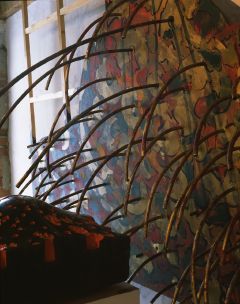

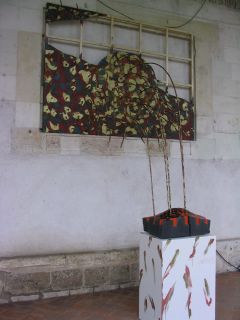
|
> The Kyoto agreements, the universal
exhibition in Aïchi 2005 about the harmony man-nature...
Society is changing and public awareness about environmental
issues is increasing. What do you think about it ?
_ Man wants to dominate nature but he is now starting to
understand that nature is a far superior system. It is
for us to adapt to this system. We cannot dominate the
universe, we are merely a small part of nature, like dust
particles in the wind.
> So we come back to the question
of interventionism: you say that you respect nature,
but you are a sculptor, you work on natural materials
with modern technological tools. Are you in search of progress ?
_ Humankind is progressing but is it going in the right
direction? The word “progress” in our era is mostly meant
in a technological and economic sense. I do not agree,
I’m looking for philosophic, intellectual and emotional
progress.
People of our time consider art and its deep research as
a second priority and those who choose this artistic path
are often left on the margins of society. Of course, in
art we do take advantage of technological improvements
and it is a very good thing, but we must not forget the
main objective and the reasons that lead us to make art
in the first place. We have “progressed” according to an
established scale of values, but maybe it is time for the
scale of values to evolve as well. They are many ways of
improving the human condition. We have responsibilities
which we cannot escape.
>京都議定書、人と自然の調和の2005年愛知万博。世界は変わって来ています。環境の再認識が問題提議されています。それについてどう思いますか
?
_ 人間は自然を支配しようとしています。しかし現在、自然が我々より優れたシステムである事を理解し始めています。我々は、このシステムと調和しなければなりません。
我々は宇宙を支配することなんかできません。我々はほんの小さなちりの様な、自然の一部でしかないのです。
>介入主義者の問題点に話を戻しましょう。あなたは自然を尊重したいと言いながら、先端技術の道具で自然の材料に取り組みます。あなたは、進歩を追求していますか
?
_ 人類は進歩しています。しかし良い方向に行っていますか?我々の時代における世界の「進歩」は、大部分は技術的で経済的な何かです
。私は同意しません。私は哲学の発展、知的な、感傷的な進歩を探しています。現代、多くの人々は我々の芸術の奥深い研究をそれ程重視せず、凡そ変な人たちだと思っています。芸術の中にも、テクノロジーの発展があり、それもとても良い事と思いますが一番大切なのは、何故芸術をしたいのかという事で、それを忘れては入れません。
我々は我々の価値観のレベルで進歩しましたが、今はその価値観自体の進歩が必要なようです。 人間としての条件を良くする多くの解決策があるとすれば、芸術家にも何か出来るはずです。
私たちには責任があります。
> Les accords de Kyoto, l’exposition
universelle de Aichi 2005 sur l’harmonie homme-nature
... La société est en train de changer et l’environnement
fait l’objet d’une prise de conscience. Qu’en penses-tu
?
_ L’homme a envie de dominer la nature, mais il est en
train de comprendre que la nature est un système qui lui
est supérieur. C’est à nous de nous intégrer dans ce système.
On ne peut pas dominer l’univers, nous ne sommes qu’une
toute petite partie de la nature, des poussières.
> On
revient donc à la problématique de l’interventionnisme :
tu déclares vouloir respecter la nature mais tu travailles
des matériaux naturels avec des technologies modernes.
N’y a-t-il pas un paradoxe ? Es tu à la recherche du Progrès
?
_ L’homme fait des progrès mais va-t-il
dans la bonne direction ?
Le mot «Progrès» s’entend principalement technologique
ou économique, je ne suis pas d’accord; je cherche le progrès
philosophique, intellectuel et sentimental. Les contemporains
de notre ère considèrent l’art et sa recherche profonde
comme une priorité de second plan, et ceux qui s’y dédient
passent souvent pour des marginaux. En art, il y a aussi
bien sur des progrès technologiques et c’est une très bonne
chose, mais il ne faut pas perdre de vue l’objectif et
la raison qui nous pousse à faire de l’art. L’outil moderne
reste un outil. Nous avons progressé selon notre échelle
de valeur, il serait bon que notre échelle de valeur évolue
à son tour. Il y a beaucoup de solutions pour améliorer
la condition humaine. Nous avons des responsabilités.
|
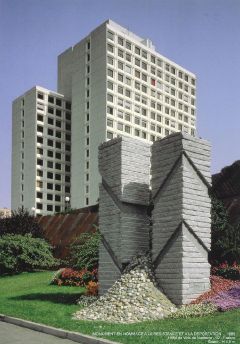
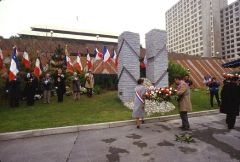
|
> You also worked for
collective memory.
_ This is an homage to resistance and deportation.
I represented the two wars, the two blocks, the two victories
that drew rivers of blood from both sides, gigantic human
sacrifices. The two main vertical grey hard blocks represent
the victories and I use the pebbles, so numerous, anonymous,
fragile, unstable and falling, to represent all the humans
sacrificed. The pebbles are fixed at the end of metal sticks
to give the impression that they are falling. I thought long
about the environment. You can see diagonal lines in the
background, I wanted to work in opposition to existing graphism
on this topic.
It is very interesting to work with so many variables: the
message, the political and historical representations and
the spatial context.
> あなたは、記念碑の仕事をしました。
_ これは、レジスタンス運動と強制移送された人に対する敬意の記しです。私は、2つの戦争、2つの御影石、お互いに多くの血を流した2つの勝利、膨大な人身の損失を表現しました。
二対の大きな垂直に立つ、灰色の硬い御影石のブロックは勝利を象徴します。そして、反対 に匿名で犠牲になった人達を表すために、もろく、崩れて安定していない、多くの玉石
を使いました。小石は、ほとんど落ちてくるような感じで、金属棒の先に穴をあけた石に固定されています。私は長い間その環境について熟考しました。後方の壁には斜めのモチーフが存在し、その斜めの形に対し、コントラストを使って作品を制作しました。この仕事は伝えたいメッセージ、政治意味合い、空間背景の入り混じる微妙な拘束の中での仕事でしたが、とても興味深いものでした。
> Tu as travaillé pour la mémoire collective.
_ C’est un hommage à la résistance et à la déportation.
Je représente les deux guerres mondiales, les deux blocs,
deux victoires qui ont fait couler tant de sang des deux
côtés, des sacrifices humains gigantesques. Les deux principaux
blocs de granit gris qui sont droits et durs représentent
les victoires, et j’utilise par opposition les galets si
nombreux, anonymes, fragiles, instables qui dégringolent
pour représenter les humains sacrifiés. Les galets sont
percés et fixés en suspension à l’aide de fer à béton,
ils sont quasiment en train tomber. J’ai beaucoup réfléchi
à l’environnement, il y a des diagonales dans le mur du
fond, je voulais travailler en opposition avec le graphisme
existant.
C’est très intéressant de travailler avec des contraintes
variées aussi délicates, le message, la représentation
politique et le contexte spatial.
|
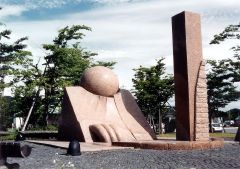
  |
_ This is a public commission
that is precisely situated on the 38th Parallel. This is
the line that divides the two Koreas and the art piece
as well. I wanted to show this border and, at the same
time, link the two blocks with a sphere. I want to symbolize
the act of getting over this feud. It represents a dream
of peace. This sculpture is a part of the Earth Weaving
project.
_ これは公共団体からの注文で、地球の緯度38度線上の場所に設置された作品です。 緯度38度線は朝鮮半島を2つに分けていますが、私のこの作品も二つに分かれています。私は、この国境を明白にすると同時に、二つのブロックを球体で結びたかったのです。
この嘆かわしい分離を乗り越えることを象徴したかった。本当の平和の夢なのです。この作品は
「地球を縫う」の一連の彫刻の一つです.
_ Cette sculpture est une commande publique, elle est
précisément située sur le 38° parallèle.
Le 38° parallèle sépare les deux Corées ainsi que cette
sculpture en deux parties. Je voulais mettre en évidence
cette frontière et en même temps relier les deux blocs
avec une sphère. Je veux symboliser le dépassement de ce
clivage. C’est un rêve de paix. Cette réalisation fait
partie du Tricot de la terre.
|
|
|
|
|
|
|
|
|
|
|
|
|
|
|